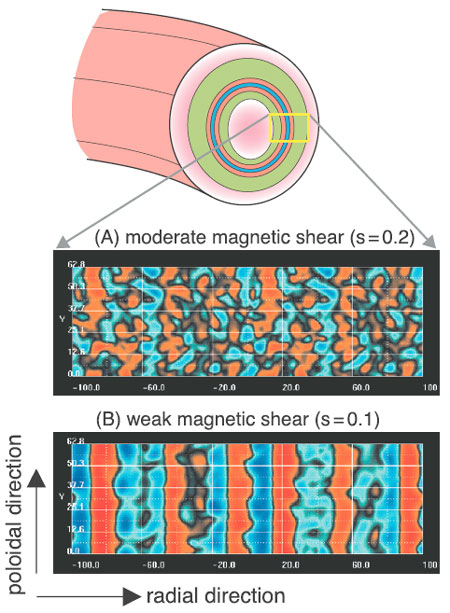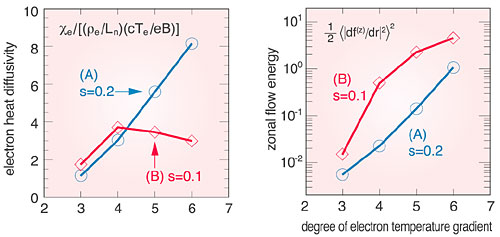2-4 | Improved Confinement by Controlling the Structure of Fluctuations in Plasmas |
 |
||
|
 |
||
|
|
In tokamak plasma aiming at thermonuclear fusion, various fluctuations having different time and spatial scales are generated. Those fluctuations sometimes progress to a turbulent state that deteriorates the tokamak confinement. In particular, the intensity of the fluctuation inevitably increases in a compact fusion reactor, since higher-pressure plasma has to be sustained in a narrower space. However, if the control of the fluctuations is achieved and characteristics are changed, a high confinement state with high-pressure plasma may be sustained.
In the Numerical Experiment of Tokamak (NEXT) research, turbulent transport simulations caused by the electron temperature gradient (ETG) mode were performed. By properly adjusting the degree of radial change in twisting rate of magnetic field lines, referred to as "magnetic shear," the characteristics of the fluctuations were changed and a state superior to the confinement states was identified. In a conventional magnetic structure with a moderate magnetic shear, the fluctuation develops into a strong turbulence, as seen in Fig. 2-7 (A). Here, the plasma particles are strongly scattered by the turbulence vortices and then the electron thermal transport is enhanced. However, as the magnetic shear is weakened, the fluctuations reveal a coherent zonal structure, i.e., zonal flow, which is elongated in the poloidal direction as seen in Fig. 2-7 (B). As a result, the scattering of the plasma particles by the fluctuations is suppressed, and the electron thermal transport is reduced compared with case (A). Fig. 2-8 shows the electron thermal diffusivity and zonal flow energy as a function of electron temperature gradient for the two magnetic shears shown in Fig. 2-7. In the moderate magnetic shear case (blue line), the electron thermal diffusivity increases, and the confinement deteriorates. Conversely, in the weak magnetic shear case, when the temperature gradient exceeds a certain threshold value, the zonal flow energy increases drastically, and the thermal diffusivity saturates or decreases. Those results suggest that once the magnetic structure is properly established, plasma has a quality that sustains the high-pressure state by spontaneously changing the structure of a fluctuation in this state. This research provides a guiding principle to realize high-performance plasma. |
| Reference Jiquan Li et al., Numerical Study of Zonal Flow Dynamics and Electron Transport in Electron Temperature Gradient Driven Turbulence, Phys. Plasmas, 11(4), 1493 (2004). |
| Select a topic in left column |
|
| Persistent Quest Research Activities 2004 Copyright (C) Japan Atomic Energy Research Institute |